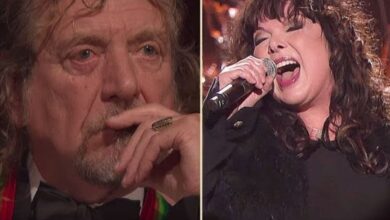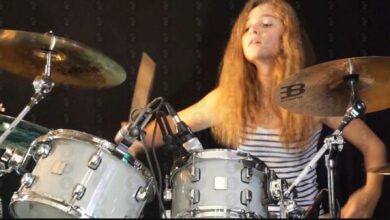Ann Wilson’s “Dream On”: A Theatrical Showcase of Power and Emotion
During her 2021 solo tour, Ann Wilson took the stage at the Hampton Beach Casino Ballroom in Hampton Beach, New Hampshire, on August 18, performing a wide-ranging set that bridged decades of her artistry. The evening flowed seamlessly between Heart classics and bold reinterpretations of timeless rock anthems. The historic venue’s intimate atmosphere amplified the rawness of her voice, turning the concert into one of the standout stops of her late-summer journey—where nostalgia intertwined with finely honed live craftsmanship.
One of the defining moments of the night came with Wilson’s powerful take on “Dream On,” Aerosmith’s immortal ballad. The song’s delicate balance between vulnerability and strength provided a perfect canvas for her seasoned voice. Audience-captured footage reflected a hushed reverence throughout the crowd—listeners completely absorbed by the unfolding performance. What emerged was not a simple homage but a vivid reimagining, marked by Wilson’s signature phrasing and emotional precision.
Wilson’s rendition revealed a masterclass in dynamic restraint. She allowed the arrangement to breathe at first, her delivery soft and introspective, gradually unfolding into controlled intensity. Her early verses whispered of reflection, while the build into the chorus carried the kind of emotional force that only years of stage experience can yield. Each high note came not from showmanship but from conviction, blending warmth and authority into a seamless crescendo.
The instrumental texture played a major role in this transformation. The guitars framed the structure with clean, open voicings, while the piano provided subtle harmonic color and depth. Drums and bass evolved in tandem with the vocal arc—shifting from a delicate pulse to a soaring drive. This layering created a gradual, cinematic swell, aligning perfectly with the song’s narrative of endurance and aspiration, turning familiar lines into a fresh, lived experience.
Wilson’s touring ensemble, The Amazing Dawgs, proved crucial to the evening’s sound. With Tom Bukovac on lead guitar, Tony Lucido on bass, Paul Moak handling both guitar and keys, and Sean Lane on drums, the band fused precision with instinct. Their interplay granted Wilson space to explore phrasing without overpowering the mix. The chemistry between musicians allowed each song to feel spontaneous—balancing tension and release in a way that only veteran players can achieve.
Setlist documentation from the night shows how carefully she constructed the performance’s emotional flow. Alongside Heart staples like “Crazy on You,” “Magic Man,” and “Barracuda,” she inserted interpretations of Led Zeppelin’s “Black Dog,” Queen’s “Love of My Life,” John Lennon’s “Isolation,” and Steve Earle’s “The Revolution Starts…”. Within that mosaic, “Dream On” emerged as the emotional core—neither an outlier nor a novelty, but a declaration of enduring musical kinship.
The performance gained further attention when professionally filmed footage from that same evening surfaced later in 2021, revealing multiple angles and refined sound mixing. These recordings complemented the fan-shot “Dream On” clip by showcasing the full stage production, from lighting cues to musicians’ unspoken communication. This broader visual context illuminated the nuances of how Wilson and her band constructed the song’s climb from fragile quietude to unrestrained catharsis.
Subsequent media coverage highlighted encore moments such as “Black Dog” and “Going to California,” positioning “Dream On” within a small suite of reinventions that celebrated classic rock lineage. Wilson’s approach was interpretive rather than imitative—each phrase bore her emotional fingerprint. Her understanding of melody and pacing turned each piece into something alive, breathing, and relevant, underscoring her lifelong ability to bridge rock’s past with her own evolving artistry.
The venue’s acoustics lent the evening an added intimacy. The Casino Ballroom’s reflective surfaces and compact scale allowed Wilson’s nuanced delivery to resonate clearly through the space. “Dream On” began as a whisper, the quiet piano and voice combination creating a spell of stillness that the audience scarcely dared to break. When the arrangement bloomed, it felt organic and unforced—a release of energy that expanded without losing its emotional core.
Her phrasing demonstrated both discipline and instinct. Wilson retained the original’s structural framework—the gradual rise from introspection to triumph—but redefined its phrasing through subtle rhythmic shifts and tonal shading. She lingered over key lines, delayed resolutions, and added bluesy inflections that infused the familiar melody with lived-in character. On repeated listening, those choices reveal how she transforms a legendary anthem into something unmistakably personal.
The Hampton Beach show fit into a concentrated series of Northeastern performances, during which “Dream On” often resurfaced. This repetition allowed her and the band to refine their collective interpretation—adjusting dynamic peaks, experimenting with tension, and exploring how each venue’s acoustics could reshape the song’s emotional temperature. By the time they reached Hampton Beach, the rendition had evolved into a confident, polished statement of creative renewal.
Contemporaneous fan accounts painted a portrait of awe and gratitude. Many praised how Wilson commanded the upper register with poise, sustaining notes with effortless control and emotional authenticity. Her refusal to imitate Steven Tyler’s flamboyance drew admiration; instead, she honored the composition’s soul through balance, tone, and storytelling. The performance resonated as proof that age and experience can deepen artistry rather than diminish it.
Because both fan-captured and official footage circulated, audiences who hadn’t attended could still reconstruct the concert’s momentum. Each piece followed a deliberate emotional trajectory: quiet introspection leading to explosive release. That compositional architecture made “Dream On” feel cinematic, its energy unfolding in measured waves. The band’s subtle gestures—eye contact, nods, controlled dynamics—translated beautifully on camera, preserving the tension and unity that filled the room.
Positioning “Dream On” within a set dominated by Heart’s defining works lent it special resonance. It acted as a bridge between Wilson’s own history and the broader canon of rock she helped shape. To long-time followers, it reaffirmed her connection to an era where authenticity ruled; to newer listeners, it stood as an invitation to discover the emotional integrity embedded in her catalog. The performance thus unified generations under a shared musical language.
The sound design reflected an understanding of space and restraint. Rather than crowding the mix, guitars stayed low and textured while keyboards cushioned the harmony. Drums added shape without dominating, and the bass provided both depth and glue. These engineering choices made Wilson’s climactic notes land as emotional payoffs instead of technical displays. The clarity of balance gave the song its emotional sweep and sense of inevitability.
All of these elements—the musicianship, venue intimacy, setlist curation, and video preservation—combine to make the August 18, 2021, performance a definitive snapshot of Wilson’s artistry in the modern era. Her “Dream On” was less a mere cover than a meditation on resilience, artistry, and time. In trusting nuance over excess, she reminded audiences that true power often lies not in the loudest moment, but in the grace between breaths.
Months after the concert, circulating footage continued to draw in new listeners, sustaining the conversation around Wilson’s artistry. The clips served as a reminder of how great performances live on beyond their night—how they invite reexamination and appreciation long after applause fades. “Dream On” in her hands became more than a song; it was an affirmation of legacy, spirit, and the unbroken connection between artist, music, and audience.





